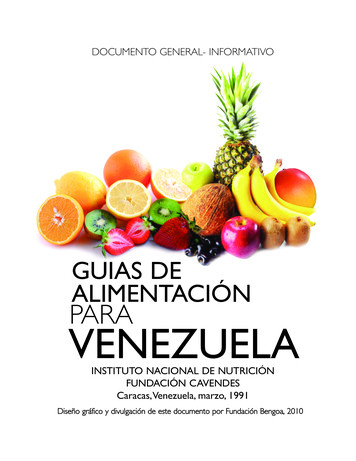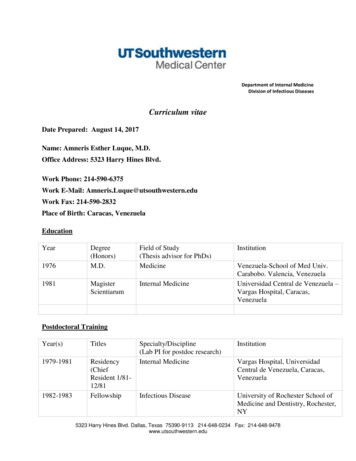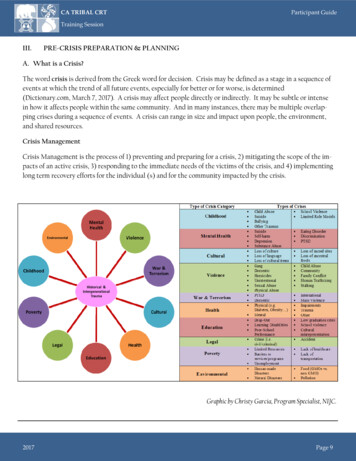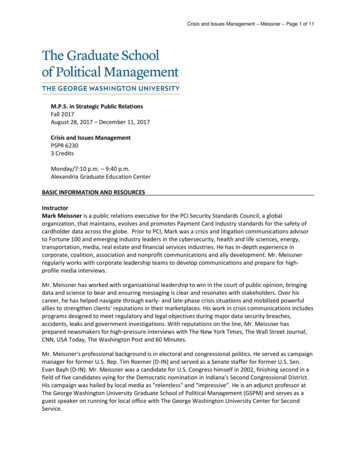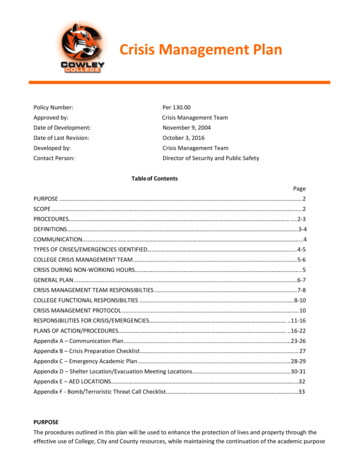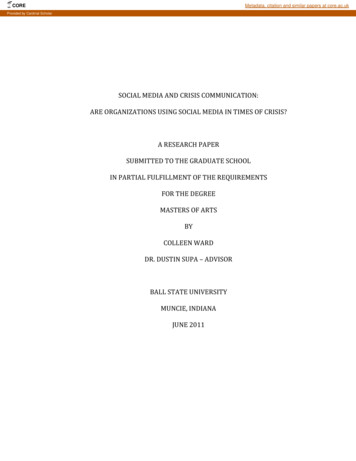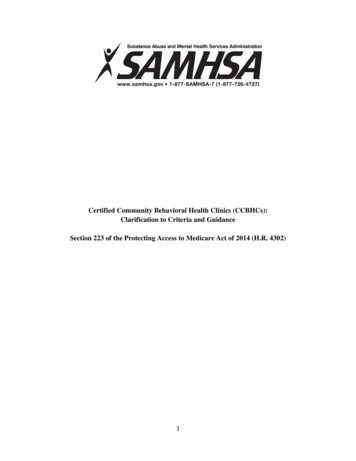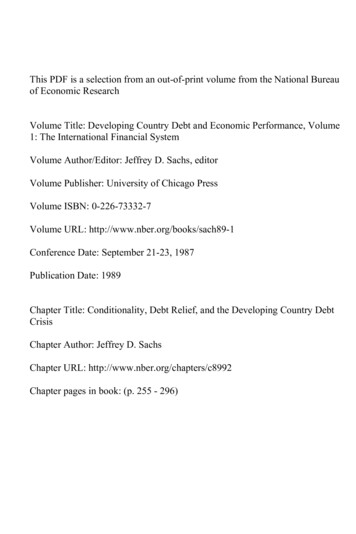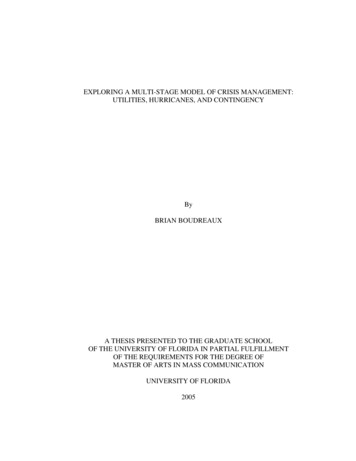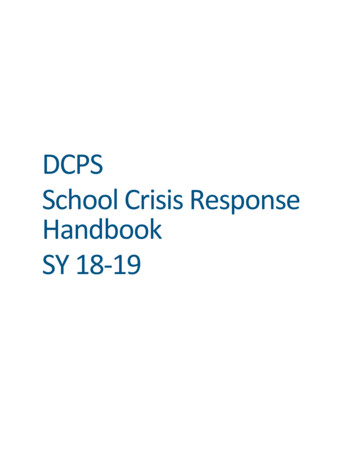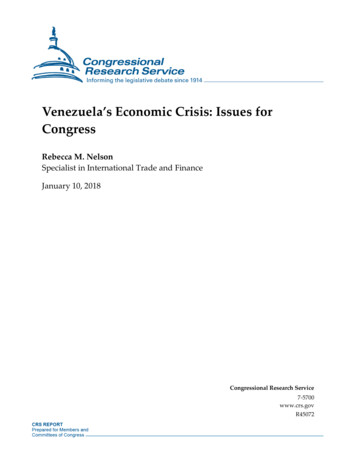
Transcription
Venezuela’s Economic Crisis: Issues forCongressRebecca M. NelsonSpecialist in International Trade and FinanceJanuary 10, 2018Congressional Research Service7-5700www.crs.govR45072
Venezuela’s Economic Crisis: Issues for CongressSummaryVenezuela’s Economic Crisis: OverviewVenezuela is facing a political crisis under the authoritarian rule of President Nicolás Maduro,who appears to have continued to consolidate power over the political opposition in recentmonths. Underpinning Venezuela’s political crisis is an economic crisis. Venezuela is a major oilproducer and exporter, and the 2014 crash in oil prices, combined with years of economicmismanagement, hit Venezuela’s economy hard. Venezuela’s economy has contracted by 35%since 2013, a larger contraction than the United States experienced during the Great Depression.Venezuela is struggling with inflation, shortages of food and medicine, substantial budget deficits,and deteriorating living conditions with significant humanitarian consequences.In response to the Maduro regime’s increasingly undemocratic actions, the Trump Administrationimposed sanctions restricting Venezuela’s access to U.S. financial markets in August 2017,increasing fiscal pressure on the government. In November 2017, the Venezuelan governmentannounced it would seek to restructure its debt. The government and the state-oil company,Petróleos de Venezuela, S.A. (PdVSA), subsequently missed key bond payments, leading creditrating agencies to issue default notices. Debt restructuring is expected to be a long and complexprocess, and it is unclear whether Venezuela will make coming debt repayments. The outlook forthe economy is bleak; the Economist Intelligence Unit forecasts the Venezuelan economy willcontract by 11.9% in 2018.Implications for U.S. Economic InterestsThe political crisis in Venezuela and low oil prices have contributed to a contraction in U.S.Venezuela trade. Venezuela is a relatively minor trading partner of the United States; thecontraction in bilateral trade is more consequential for Venezuela, for which the United States isits largest trading partner. In response to the political and economic instability, several large U.S.companies have left Venezuela or curtailed operations there.U.S. investors holding Venezuelan and PdVSA bonds could face substantial losses if Venezuelasuspends payment or seeks an aggressive restructuring of its debt. Bondholders are in the earlystages of organizing to enter restructuring negotiations and/or pursue legal challenges against theVenezuelan government. Venezuelan dollar-denominated bonds were issued under New York law,and bondholder lawsuits seeking repayment would take place in U.S. courts. Legal challengescould result in the seizure of Venezuela’s assets in the United States, such as CITGO (whoseparent company is PdVSA), oil exports, and cash payments for oil exports.Venezuela’s precarious fiscal position also raises concerns for U.S. energy security. In 2016,Venezuela’s state oil company PdVSA secured a loan from the Russian state-oil companyRosneft. PdVSA used 49.9% of its shares in CITGO as collateral. If PdVSA defaults on itsRosneft loan, it is not clear whether Venezuela’s portion of CITGO ownership would betransferred to Rosneft. Reportedly, Rosneft is negotiating to swap its collateral in CITGO forother PdVSA assets.Looking AheadCongress is considering providing humanitarian aid to Venezuela through nongovernmentalorganizations. If the Maduro government or a new government in Venezuela engages in asignificant reorientation of policy, U.S. policymakers may be interested in providing broadereconomic support to rebuild Venezuela’s economy. Policymakers might explore how theinternational community, particularly the International Monetary Fund (IMF), could provide aninternational financial assistance package, and whether debt incurred by the National ConstituentCongressional Research Service
Venezuela’s Economic Crisis: Issues for CongressAssembly, widely viewed as an illegitimate legislature, should be enforced. If the Maduro regimestays in power and does not reorient its policies, the United States may revisit its policies andpotentially pursue harsher sanctions.For additional information on Venezuela from CRS, see CRS Report R44841, Venezuela:Background and U.S. Policy; CRS In Focus IF10230, Venezuela: Political and Economic Crisisand U.S. Policy; and CRS In Focus IF10715, Venezuela: Overview of U.S. Sanctions.Congressional Research Service
Venezuela’s Economic Crisis: Issues for CongressContentsIntroduction . 1Economic Crisis in Venezuela . 1Economic Mismanagement during the Oil Boom . 2Crash in Oil Prices and Economic Crisis . 3Default and Debt Restructuring . 5Economic Outlook . 7Potential Issues for Congress. 7Impact on U.S. Trade and Investment with Venezuela. 7U.S. Trade with Venezuela . 7U.S. Firms Operating in Venezuela . 8U.S. Bondholders . 9CITGO Ownership . 10Possible Future Economic Support for Venezuela . 11Potential IMF Program . 11Potential Repudiation of “Odious” Debt. 12Looking Ahead . 12FiguresFigure 1. Venezuela GDP per capita . 2TablesTable 1. Venezuela’s Economic Crisis: Key Indicators . 4ContactsAuthor Contact Information . 13Congressional Research Service
Venezuela’s Economic Crisis: Issues for CongressIntroductionVenezuela continues to be in the throes of a deep political crisis under the authoritarian rule ofPresident Nicolás Maduro.1 Narrowly elected to a six-year term in 2013 following the death oflongtime populist President Hugo Chávez (1999-2013), Maduro is unpopular. Despite seriouseconomic challenges and recurring protests, Maduro has various policies, including use of thecourts and security forces, to repress and divide the political opposition. The Maduro regime hasbeen accused of committing serious human rights abuses; creating a deepening humanitariancrisis in Venezuela; establishing an illegitimate legislature, the National Constituent Assembly,which has usurped power from the democratically elected National Assembly; engaging inrampant corruption; and persecuting the political opposition.2Underpinning the political crisis is an acute and increasingly unstable economic crisis.Venezuela's economy is built on oil, which accounts for more than 90% of the country's exports.The 2014 collapse in oil prices hit Venezuela’s economy hard. Venezuela’s economy hascontracted by 35% since 2013, a larger contraction than the United States experienced during theGreat Depression in the 1930s.3 In addition, the crisis is marked by inflation, shortages ofconsumer goods, default on the government’s debt obligations, and deteriorating living conditionswith significant humanitarian consequences.Congress has long-standing interests in both U.S.-Venezuela relations and foreign economiccrises that affect U.S. economic interests. This report analyzes the economic crisis in Venezuela,arguably the most acute crisis in the global economy today, including the causes, policy responsesby the government, and recent developments. The report also examines how the crisis affects U.S.economic interests, including U.S. investors’ holdings of Venezuelan bonds, Venezuelan assets inthe United States, U.S.-Venezuelan trade and direct investment, and possible future involvementof the International Monetary Fund (IMF) in the crisis.Economic Crisis in VenezuelaFor decades, Venezuela was one of South America’s most prosperous countries, but now lagsbehind other key economies in the region (Figure 1). Venezuela has the world’s largest provenreserves of oil in the world, and its economy is built on oil.4 Oil accounts for more than 90% ofVenezuelan exports and oil sales fund the government budget. Oil exports also provide thecountry with the foreign exchange it needs to import consumer goods. After years of economicmismanagement under President Hugo Chávez, Venezuela was not well equipped to withstand thesharp fall in oil prices in 2014. Economic conditions have deteriorated rapidly under PresidentMaduro. In November 2017, the government’s increasingly dire fiscal situation came to a head, asthe government announced it would seek to restructure its debt.1For more on the political crisis in Venezuela and U.S. CRS Report R44841, Venezuela: Background and U.S. Policy,by Clare Ribando Seelke and Rebecca M. Nelson, and CRS In Focus IF10230, Venezuela: Political and EconomicCrisis and U.S. Policy, by Clare Ribando Seelke and Mark P. Sullivan.2For example, see Executive Order 13808, “Imposing Additional Sanctions With Respect to the Situation inVenezuela,” August 24, 2017.3Ricardo Hausmann, “Venezuela’s Unprecedented Collapse,” Project Syndicate, July 31, 2017.4“How Chávez and Maduro Have Impoverished Venezuela,” Economist, April 6, 2017.Congressional Research Service1
Venezuela’s Economic Crisis: Issues for CongressFigure 1.Venezuela GDP per capitaSource: IMF, World Economic Outlook Database, October 2017.Notes: An international dollar would buy in the cited country an amount of goods and services comparable towhat a U.S. dollar would buy in the United States. This term is used in conjunction with Purchasing Power Parity(PPP) data.Economic Mismanagement during the Oil BoomVenezuela benefited from the boom in oil prices during the 2000s. When Hugo Chávez tookoffice in 1999, oil was 10 a barrel. Oil prices steadily rose over the following several years,reaching a peak of 133 a barrel in July 2008.5 Between 1999 and 2015, the Venezuelangovernment earned nearly 900 billion from petroleum exports, with about half ( 450 billion)earned between 2007 and 2012 (Chávez’s second term).6President Chávez used the oil windfall to spend heavily on social programs and expand subsidiesfor food and energy. Social spending as a share of GDP rose from 28% to 40% between 2000 and2013, a much bigger rise than in Latin America’s other large economies.7 Chávez borrowedagainst future oil exports, running budget deficits in nine of the years when he was in office(1999-2013).8 Venezuela’s public debt more than doubled between 2000 and 2012, from 28% ofGDP to 58% of GDP.9 Additionally, Chávez used oil to expand influence abroad, for examplethrough PetroCaribe, a program that allowed Caribbean countries to purchase oil at below-marketprices. The Chávez government also engaged in widespread expropriations and nationalizations,with the number of private companies dropping from 14,000 in 1998 to 9,000 in 2011.10 It alsoadopted currency and price controls.5U.S. Energy Information Administration, Europe Brent Spot Price FOB, hx?n pet&s rbrte&f m.6Michael M. McCarthy, “Venezuela’s Manmade Disaster,” Current History, February 2017, pp. 61-67.7“How Chávez and Maduro Have Impoverished Venezuela,” Economist, April 6, 2017.8IMF, World Economic Outlook Database, October 2017.Ibid.910Stephen Keppel, “5 Ways Hugo Chávez Has Destroyed the Venezuelan Economy,” ABC News, January 17, 2013.Congressional Research Service2
Venezuela’s Economic Crisis: Issues for CongressSubstantial government outlays on social programs helped Chávez gain political favor and drivedown poverty rates in Venezuela, from 37% in 2005 to 25% in 2012.11 However, widespreadeconomic mismanagement had long-term consequences. Government spending was not directedtoward investment that could have helped increase economic productivity and reduce its relianceon oil. Expropriations and nationalizations discouraged foreign investment that could haveprovided the country with increased expertise and capital. Price controls created marketdistortions and stifled the private sector. Economic growth and poverty reduction in Venezuelalagged behind the rest of South America.12Crash in Oil Prices and Economic CrisisWhen Nicolás Maduro was elected President in April 2013, he inherited economic policies thatwere broadly viewed as unsustainable and overly reliant on proceeds from oil exports. When oilprices crashed in 2014, the Maduro government was ill-equipped to soften the blow to theVenezuelan economy. While many other major commodity producers used the boom years tobuild foreign exchange reserves or sovereign wealth funds to mitigate risks from big swings incommodity prices, the Chávez government created no such stabilization fund to guard against apotential future fall in oil prices.13 Instead, Chávez had borrowed on the expectation that oilprices would remain high.The crash in oil prices led to a sharp decline in government revenue and, combined with thegovernment’s policy choices, triggered a broad economic crisis.14 Venezuela’s economy isestimated to have contracted by nearly 35% between 2012 and 2017.15 The fall in oil pricesstrained public finances; instead of adjusting fiscal policies through tax increases and spendingcuts, the Maduro government tried to address its growing budget deficit by printing money, whichled to inflation. Inflation, about 20% in 2012, was projected to exceed 1,100% by the end of2017.16 The government has tried to curb inflation through price controls, although these controlshave been largely ineffective in restricting prices, as supplies have dried up and transactions havemoved to the black market.17 Unemployment in Venezuela is forecast to reach 26% in 2017, morethan triple the level of unemployment in 2012.18 Table 1 provides a snapshot of changes in keyeconomic indicators for Venezuela since 2013.Until recently, the Maduro government had committed to repaying its debts despite tightresources, fearing the legal challenges from creditors that plagued Argentina for more than adecade after its default in 2001.19 Such legal challenges against the Venezuelan government couldresult in the seizure of Venezuela’s overseas assets, such as CITGO, a subsidiary of Venezuela’s11Economic Commission for Latin America and the Caribbean (ECLAC), Social Panorama of Latin America, 2014,Table 1, 2/37627/4/S1420728 en.pdf.12Michael M. McCarthy, “Venezuela’s Manmade Disaster,” Current History, February 2017, pp. 61-67.13“How Chávez and Maduro Have Impoverished Venezuela,” Economist, April 6, 2017.14For more on low oil prices, see CRS In Focus IF10493, Effects of Lower Oil Prices, by Robert Pirog.15IMF, World Economic Outlook Database, October 2017; Ricardo Hausmann, “Venezuela’s UnprecedentedCollapse,” Project Syndicate, July 31, 2017.16IMF, World Economic Outlook Database, October 2017.17“How Chávez and Maduro Have Impoverished Venezuela,” Economist, April 6, 2017.18IMF, World Economic Outlook Database, October 2017.19For more on the Argentina default and ensuing legal cases, see CRS Report R43816, Argentina: Background andU.S. Relations, by Mark P. Sullivan and Rebecca M. Nelson and CRS Report R41029, Argentina’s Defaulted SovereignDebt: Dealing with the “Holdouts”, by J. F. Hornbeck.Congressional Research Service3
Venezuela’s Economic Crisis: Issues for Congressstate oil company, Petróleos de Venezuela, S.A. (PdVSA); oil shipments; and cash payments foroil exports. Maduro’s commitment to debt service came at a high cost: to meet its internationalpayments, the government tightened restrictions on access to foreign currency, imposed pricecontrols, and cut imports. Venezuela’s imports of goods fell from 62.9 billion in 2013 to 21.4billion in 2016.20 Venezuela relies heavily on imports for most consumer goods, and cuts toimports led to severe shortages of food and medicine, creating a humanitarian crisis.21Table 1. Venezuela’s Economic Crisis: Key IndicatorsIndicatorPre-Economic Crisis(2013)Latest Data(*2016 or **2017Forecasted)% ChangeExports of goods 82.7 billion 27.0 billion*-67%Imports of goods 62.9 billion 21.4 billion*-66%62.2 billion bolívares41.2 billion bolívares**-34% 17,980 11,290**-37%57%1,133%**1,888%Unemployment, % of population7.5%26.4%**252%Government deficit, % of GDP14.1%18.5%**31% 21.5 billion 10.0 billionc-53%GDP, constant prices, Venezuela’snational currency, the bolívarGDP per capitaaInflation, % change inpricesbGovernment reservesSource: IMF World Economic Outlook, International Financial Statistics, and Direction of Trade Statistics Databases,accessed December 18, 2017.Notes:a. International dollars (adjusted for purchasing power parity); see Notes in Figure 1.b. End of period consumer prices.c. Data is for the fourth quarter of 2013 and the third quarter of 2017.The Venezuelan government pursued a variety of policies to fill its funding gaps and avoiddefault. The government approached allies China and Russia for financing, securing loans to berepaid through future oil exports (“oil-for-loan” deals), although it fell behind on these deals. InMay 2017, the Venezuelan central bank raised funds through the sale of 2.8 billion in PdVSAbonds to Goldman Sachs Asset Management at a steep discount (Goldman paid 865 million).22The deal was controversial, and the government had difficulty finding buyers for a similartransaction in subsequent months.23 The Venezuelan government was running out of foreignexchange reserves to make debt payments, with official reserves down from 21.5 billion at the20IMF, Direction of Trade Statistics Database, accessed December 18, 2017.For more information on the humanitarian crisis in Venezuela, see CRS Report R44841, Venezuela: Background andU.S. Policy, by Clare Ribando Seelke and Rebecca M. Nelson. Also see Jared Genser, “Venezuela Needs InternationalIntervention Now,” New York Times, May 30, 2017; Meredity Kohut and Isayen Herrea, “As Venezuela Collapses,Children are Dying of Hunger,” New York Times, December 17, 2017.22Kejal Vyas, Anatoly Kurmanaev, and Julie Wernau, “Goldman Sachs Under Fire for Venezuela Bond Deal,” WallStreet Journal, May 30, 2017; Kejal Vyas and Anatoly Kurmanaev, “Goldman Sachs Bought Venezuela’s State OilCompany’s Bonds Last Week,” Wall Street Journal, May 28, 2017.23Matt Wirz, and Carolyn Cui, "Venezuela's Humanitarian Crisis Tests Wall Street Ethics," Wall Street Journal, June19, 2017.21Congressional Research Service4
Venezuela’s Economic Crisis: Issues for Congressend of 2013 to 10 billion in the third quarter of 2017.24 In August 2017, new U.S. sanctionsexacerbated the government’s precarious fiscal position. Specifically, the August 2017 sanctionsrestrict Venezuela’s ability to borrow from U.S. investors or access U.S. financial markets.25 TheMaduro government is pursing the creation of a new currency, “petros” backed by oil, gas, gold,and diamonds, as a way to circumvent sanctions.Default and Debt RestructuringAfter months of speculation about if and when Venezuela would default, on November 2, 2017,President Maduro announced in a televised address that the country would seek to restructure andrefinance its debt. The announcement signaled a significant shift in policy and highlighted thegovernment’s dire fiscal situation, but Maduro provided few details about how the restructuringwould proceed. While it is difficult to find reliable data on the composition of Venezuelan debt, itis estimated that Venezuela owes about 64 billion to bondholders, 20 billion to China andRussia, 5 billion to multilateral lenders (such as the Inter-American Development Bank), andtens of billions to importers and service companies in the oil industry.26 Maduro blamed U.S.sanctions for Venezuela’s need to restructure, arguing that U.S. sanctions made it impossible forthe government to find new financing.27Any comprehensive restructuring of Venezuelan debt is expected to be a long and complexprocess, due to the following factors: the number of parties involved, including hundreds or even thousands ofbondholders who are in the early stages of organizing, as well as China andRussia, whose lending to Venezuela may be driven in part by geopoliticalconsiderations;28legal challenges likely to be initiated by bondholders, which could take years toresolve and could result in the seizure of Venezuelan assets in the United States,including CITGO (owned by PdVSA), oil shipments, and cash payments foroil;29differences in legal provisions in different bonds, including differences betweenthe sovereign and PdVSA bonds;30U.S. sanctions, which prohibit U.S. investors from accepting any new debt issuedin a debt restructuring or from engaging with Vice President Tareck El Aissamiand Economy Minister Simon Zerpa, who are leading the debt negotiations andsubject to U.S. sanctions for drug-trafficking and corruption charges; and24IMF, International Financial Statistics, accessed December 18, 2017.For more on the financial sanctions, see CRS Insight IN10766, New Financial Sanctions on Venezuela: Key Issues,by Rebecca M. Nelson and CRS In Focus IF10715, Venezuela: Overview of U.S. Sanctions, by Mark P. Sullivan.26John Paul Rathbone and Robin Wigglesworth, “Venezuela Debt: US, Russia, and China Play for High Stakes,”Financial Times, November 22, 2017.27Katia Porzecanski, Patricia Laya, Ben Bartenstein, and Christine Jenkins, “Venezuela Will Seek to Restructure Debt,Blaming Sanctions,” Bloomberg, November 3, 2017; Anna Gelpern, “Venezuela is Like. (Part I),” Credit Slips,August 3, 2017.28Robin Wigglesworth, “Debt Restructuring Battle is Brewing over Venezuela,” Financial Times, November 20, 2017.29Lee C. Buchheit and G. Mitu Gulati, “How to Restructure Venezuelan Debt,” Draft Working Paper, July 21, 2017.30Anna Gelpern, “Venezuela is Like. (Part II),” Credit Slips, August 6, 2017.25Congressional Research Service5
Venezuela’s Economic Crisis: Issues for Congress lack of any economic reform agenda in Venezuela to accompany therestructuring, such as an IMF program.Maduro stressed his promise to continue debt service during negotiations with creditors, likely aneffort to evade legal challenges from bondholders. However, the government and PdVSA missedsome bond interest payments in mid-November, leading credit rating agencies and a New Yorkbased derivatives group (the International Swaps and Derivatives Association, ISDA) to issuedefault notices.31To advance its goal of debt restructuring, the Venezuelan government organized a bondholdersmeeting in Caracas on November 13, 2017. The meeting, while touted by the government as asign of good faith in negotiations with creditors, provided little insight into how negotiationswould proceed.32 Reportedly the bondholder meeting was sparsely attended, no bondholders wereallowed to ask any questions publicly, and the meeting concluded after 30 minutes.33 Critics havealso questioned why the government appointed two sanctioned individuals to lead its negotiatingteam.Some analysts have tried to parse Maduro’s strategy, if any exists, for dealing with privatebondholders.34 Maduro’s stated goal of restructuring and subsequent default notices drove downthe value of Venezuelan debt trading in secondary markets. Some analysts have argued that thiswas Maduro’s intent, and strengthens the government’s hand in restructuring negotiations. Thereis also some speculation that the Venezuela government will strategically default on itsgovernment bonds, but not the PdVSA bonds. The reasoning is that it may be harder to seize thegovernment’s assets rather than a company’s assets, but it is unclear how the strategy would playout in courts given the tight linkages between the government and PdVSA.35Although China and Russia have both provided financial support to Venezuela, the two creditorgovernments are increasingly taking divergent approaches to Venezuela’s mounting fiscalproblems. In mid-November, Russia agreed to restructure 3.15 billion in debt owed byVenezuela on favorable terms, despite Russia’s own fiscal pressures. This eased the fiscalpressures facing the Venezuelan government, and demonstrates the geopolitical significance ofVenezuela to Russia. In contrast, China seems to give priority to the economic value of itsinvestments in Venezuela over geopolitical concerns. In late November, a U.S. subsidiary ofSinopec, one of China’s biggest state-owned oil companies, sued PdVSA in a U.S. court for latepayments.36 PdVSA settled with the subsidiary in December, perhaps showing the importance toVenezuela of maintaining good relations with the Chinese government.37 It appears to be the firstlegal challenge to Venezuela relating to its debt payment obligations.In addition to restructuring debt owed to Russia, the Venezuelan government is seeking sources ofcash to keep its finances afloat. In December, the government secured a 400 million credit line31John Paul Rathbone and Robin Wigglesworth, “Venezuela Debt: US, Russia, and China Play for High Stakes,”Financial Times, November 22, 2017; Corina Pons, “Venezuela Ruled in Default by Trade Group after Bond PaymentDelays,” Reuters, November 16, 2017.32Ben Bartenstein, Katia Porzecanski, and Patricia Laya, “Venezuela’s Bondholder Meeting Is a Bust as S&P DeclaresDefault,” Bloomberg, November 13, 2017.33Patricia Laya, Jose Enrique, Arrioja, and Fabiola Zerpa, “Venezuela’s 30 Minutes of Debt Talks Leave BondholdersGuessing,” Bloomberg, November 13, 2017.34Venezuela Seeks the Restructuring of its Massive Foreign Debts,” Economist, November 9, 2017.35“Venezuela Default More Likely on Sovereign Bonds than PdVSA Bondholders,” Reuters, December 15, 2017.36Jonathan Wheatley, “Lawsuit Shows China Losing Patience with Venezuela,” Financial Times, December 6, 2017.37“Venezuela’s PdVSA Settles Lawsuit with China’s Sinopec,” Reuters, December 12, 2017.Congressional Research Service6
Venezuela’s Economic Crisis: Issues for Congressfrom the Latin American Development Bank (Corporacion Andina de Fomento, CAF), of whichthe United States is not a member.Economic OutlookIn October 2017, the IMF projected Venezuela’s economy to contract by 6% in 2018 and 2% in2019.38 These projections have been substantially revised since the government announced plansto restructure its debt and was declared in default by several credit rating agencies. In December2017, the Economist Intelligence Unit projected that Venezuela’s economy will contract by 11.9%in 2018 and 5.4% in 2019, a more significant contraction in economic growth than it or the IMFenvisioned just two months prior.39Venezuela is running a relatively large budget deficit, estimated at 18.5% of GDP in 2017.40 It isunclear how restructuring and/or default will impact Venezuela’s finances, in part because it isunclear whether the government intends, or will be able, to continue repaying debts during thenegotiations.41 If the government does suspend debt repayments, it could in the short term redirectfunds to domestic objectives such as increasing imports of food and medicine, which could helpbolster domestic political support for the Maduro regime. In the longer term, however,suspending payments to creditors could result in a substantial loss of government revenue, ifcreditors are able to seize oil exports or funds tied to oil exports.Potential Issues for CongressImpact on U.S. Trade and Investment with VenezuelaWhile there has been minimal spillover of Venezuela’s economic crisis in broader global financialmarkets, the crisis has a number of policy implications for U.S. economic interests. Venezuela’seconomic and broader political crisis, combined with low oil prices, has contributed to acontraction in U.S.-Venezuela trade, and some major U.S. firms operating in Venezuela have leftor curtailed operations. Many U.S. investors hold Venezuelan government and PdVSA bonds, andU.S. investors could suffer losses and become involved in complicated legal proceedings againstthe Venezuelan government. There are also concerns that dealings between PdVSA and theRussian state-oil company Rosneft could result in Rosneft taking partial ownership of PdVSA’sTexas-based subsidiary, CITGO.U.S. Trade with VenezuelaThe combination of low oil prices, Venezuela’s declining oil production, and the overall declinein U.S. oil imports, as well as the country’s major political and economic crisis, has contributed toa sharp decrease in U.S. trade with Venezuela. U.S. commodity exports to Venezuela have fallenby 60% since 2013, from 13.2 billion to 5.2 billion in 2016.42 U.S. commodity imports fromVenezuela have fallen by about two-thir
behind other key economies in the region (Figure 1). Venezuela has the world's largest proven reserves 4of oil in the world, and its economy is built on oil. Oil accounts for more than 90% of Venezuelan exports and oil sales fund the government budget. Oil exports also provide the country with the foreign exchange it needs to import consumer .
